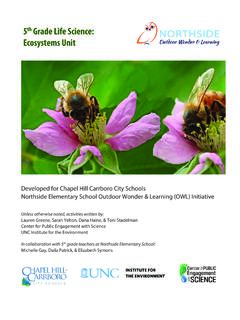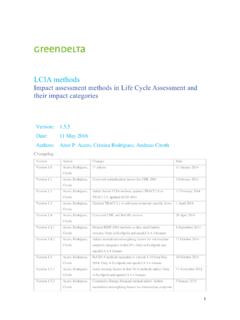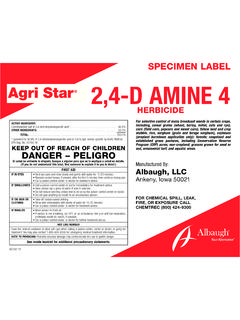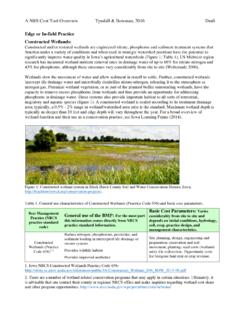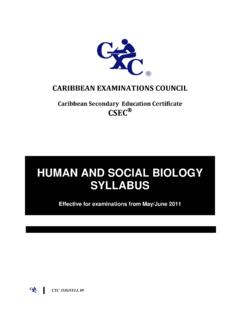Transcription of Field identification of the 50 most common plant families ...
1 Field identification of the 50 most commonplant families in temperate regions(including agricultural, horticultural, and wild species)by Lena 2014, All rights : Listed characteristics are the most common characteristics; there might be exceptions in rare or tropical species. This compendium is available for free download without cost for non-commercial uses at ~struwe/. The author welcomes updates and families :AmaranthaceaeAmaryllidaceaeAnac ardiaceaeApiaceaeAraceaeAraliaceaeAsphod elaceaeAsteraceaeBetulaceaeBoraginaceaeB rassicaceaeBromeliaceaeCactaceaeCampanul aceaeCaryophyllaceaeCurcurbitaceaeCupres saceaeCyperaceaeEquisetaceaeEricaceaeEup horbiaceaeFabaceaeFagaceaeGeraniaceaeIri daceaeJuglandaceaeJuncaceaeLamiacceaeLau raceaeLiliaceaeMagnoliaceaeMalvaceaeMora ceaeMyrtaceaeOleaceaeOrchidaceaeOrobanch aceaePinaceaePlantaginaceaePoaceaePolygo naceaeRanunculaceaeRosaceaeRubiaceaeRuta ceaeSalicaceaeScrophulariaceaeSolanaceae Overall phylogeny living land plantsBryophytesLycophytesFerns and Fern AlliesConifersBasal angiospermsMonocotsEudicotsBasal eudicotsRosidsAsteridsCaryophyllalesCamp anulidsLamiidsFabidsMalvidsMosses, liverworts, , , cycads and cedars, s.
2 Lat.(incl. Chenopodiaceae) AMARANTH FAMILY Herbs or shrubs (rarely trees or vines), often reddish, many salt-loving plants (halophytes) Stems often succulent, and/or jointed Leaves alternate, simple (A) No stipules Flowers small, actinomorphic (B) Sepals usually 3-5, free or fused basally, surrounding the fruit (C) Petals absent Stamens as many as sepals, positioned on the inside of each sepal Ovary superior or half-inferior, 1-3 fused carpels, one locule andone ovule, basal placentation Fruit a berry, capsule, or nutlet Seeds strongly curved (D)Note: Chenopodiaceae is now included in : beet (Beta), amaranth, quinoa (Amaranthus), lamb s quarters (Chenopodium), spinach (Spinacia), cock s comb (Celosia). BAmaranthaceae: Caryophyllales: Core EudicotsChenopodiumADC Lena Struwe 2014,All rights (incl. Alliaceae)AMARYLLIS AND ONION FAMILY Biennial or perennial herbs (monocots) with bulb (A) at base Simple, narrow leaves in basal rosette (B), often only in two directions (2-ranked) Inflorescence a terminal umbel (C), sometimes with bulblets on a leafless stem Tepals 6, anthers 6 Hypanthium (fused tepals and base of stamens) often present (not in Allium) Ovary superior (D) or inferior, 3-carpellate Fruit a capsule Seeds many, hard, black (covered with phytomelans) Onion-like smell in AlliumABCDEA lliumAmaryllidaceae: Asparagales: Monocotyledons Lena Struwe 2014,All rights AMARYLLIS and ONIONFAMILYE xamples: amaryllis (Hippeastrum), snowdrop (Galanthus), belladonna-lily (Amaryllis), spider lily (Lycoris, Hymenocallis), daffodil (Narcissus), clivia (Clivia), swamp lily (Crinum).
3 Spring snowflake (Leucojum), Aztec lily (Sprekelia), zephyr lily (Zephyranthes), garlic, onion, leek, chives (Allium). GalanthusAmaryllidaceae: Asparagales: Monocotyledons Lena Struwe 2014,All rights CASHEW FAMILY Trees, shrub, lianas, or perennial herbs With resin ducts and laticifers (sap often toxic) Often pinnately compound leaves (A) Flowers 5-merous, small, with nectary disc (B) Stamens 5 or 10 (B) One ovule per carpel, 1-5 carpels in a fruit Fruit a drupeExamples: cashew (Anacardium), sumac (Rhus), poison ivy and poison oak (Toxicodendron), pistachio (Pistacia), mango (Mangifera), pink peppercorn tree (Schinus). ABAnacardiaceae: Sapindales: Malvids: Rosids: Core EudicotsToxicodendron Lena Struwe 2014,All rights CARROTFAMILY herbaceous Aromatic, some very poisonous (oils, resins) Stems hollow (A) Leaves alternate, often dissected or lobed (B), pinnate venation Leaf petiole broadened with sheath (C) surrounding stem or base of leaf Flowers arranged in double umbels (D); small, white or yellow, many Petals 5, not fused, sepals reduced or absent Fruit a dry fruit that divides into 2 parts (E, schizocarp)Notes: Apiaceae sometimes includes Araliacea.
4 The characters listed here only work well for the temperate herbaceous : parsley (Petroselinum), dill (Anethum), poison hemlock (Conium), cilantro (Coriandrum), celery (Apium), Queen Anne s lace/carrot (Daucus), caraway (Carum), cumin (Cuminum), fennel (Foeniculum). ABCDEM yrrhisApiaceae: Apiales: Campanulids: Asterids: Core Eudicots Lena Struwe 2014,All rights MILKWEED & DOGBANE FAMILY Leaves opposite, simple (A),pinnate venation Leaf margin smooth (A) Stipules absent (A) Latex (milky sap) in all branches and leaves Sepals 5, Petals 5, sometimes fused Ovary superior Anthers often fused, and sometimes fused with style head to a gynostegium (B), pollen in pollinia (C) in some species Fruit usually with 2 separate carpels, developing into 1-2 dry capsular parts or berries Seeds often with tufts of hairs at one end (D)Note: Asclepiadaceae is now included in : dogbane (Apocynum), milkweed (Asclepias), rosy/Madagascar periwinkle (Catharanthus), vinca (Vinca), oleander (Nerium), frangipani (Plumeria), hoya (Hoya), bluestar (Amsonia), mandevilla (Mandevilla).
5 DBCAV incetoxicumApocynaceae: Gentianales: Lamiids: Asterids: Core Eudicots Lena Struwe 2014,All rights GINSENG FAMILY Trees, shrubs, lianas, or herbs. Leaves alternate, simple (A), palmate, or pinnate (often divided or lobed) Flowers arranged in terminal umbels(B), heads, or panicle; small, white or yellow, many (B) Petals 5, not fused, sepals reduced or absent ( C) Fruit a berry (D), drupe or dry fruitExamples: English Ivy (Hedera), ginseng (Panax), umbrella tree (Schefflera), aralia (Aralia).ABCDA piaceae: Apiales: Campanulids: Asterids: Core Eudicots Lena Struwe 2014,All rights ARUM FAMILY Shrubs, vines, or herbs, sometimes aquatic; often fleshy Rhizomes (A), corms, tubers common Leaves simple, with reticulate or parallel venation (B) Inflorescence a terminal spadix of tiny flowers, subtended by a colored leaf/bract (spathe) (C) Flowers sometimes unisexual, highly reduced, sessile (D) Fruits usually berries (E)Note: Lemnaceae is now includedin the : taro (Colocasia), anthurium (Anthirium), arum (Amorphophallusand other genera), elephant s ear (Caladium), dumb cane (Dieffenbachia), duckweeds (Lemna, Wolffia), and many cultivated plants (Monstera, Philodendron, Spathiphyllum).
6 ABCDEC allaAraceae: Alismatales: Monocotyledons Lena Struwe 2014,All rights PALM FAMILY Trees or shrubs, sometimes lianas or herbs Stem usually unbranched, without secondary growth Leaves large, pinnately or palmately divided (A), rarely simple Sheath at base of leaf Inflorescence axillary, large (B) Flowers sessile Tepals 6 Fruit a fleshy drupe with one seed (C)Examples: coconut (Cocos), date palm (Phoenix), oil palm (Elaeis), sago palm (Metroxylon), betel palm (Areca), rattan (Calamus), A a Palm (Euterpe), saw palmetto (Serenoa). ABCA recaceae: Arecales: Commelinids: MonocotyledonsAreca Lena Struwe 2014,All rights ALOE FAMILY Herbs, shrubs, rarely trees Succulents, especially leaves Leaves simple, alternate, parallel-veined, often with spiny or dentate margin (A) Inflorescence a raceme or panicle Flowers actinomorphic or zygomorphic Tepals 3+3, sometimes fused Stamens 6 Ovary superior, 3 fused carpels, 3 locules, axile placentation (B) Fruit a capsule Seed with an arilNote: Many of these genera were previously placed in Liliaceae.
7 Examples: aloe (Aloe), haworthia (Haworthia), asphodel (Asphodelus), red hot poker (Kniphofia). AAsphodelaceae: Asparagales: MonocotyledonsAloeB Lena Struwe 2014,All rights & SUNFLOWER FAMILY Herbaceous usually Leaves variable, with pinnate venation Inflorescence a head (capitulum, A) with many flowers,with involucral bracts surrounding it (B) Flowers small, either tubular (C) or tongue-shaped (ligulate) Sepals absent Petals fused, usually with 5 small lobes (C) Anthers fused into a ring around style Ovary inferior Fruit a dry nut (achene, D), oftenwith hairs on top (pappus)Examples: Echinacea (Echinacea), dandelion (Taraxacum), burdock (Arctium), mugwort, wormwood (Artemisia), chrysanthemum (Dendranthema), ox-eye daisy (Leucanthemum), asters (Aster, etc.), thistles (Cirsium, Carduus), sunflower (Helianthus), artichoke (Cynara), ragwort, groundsel (Senecio), knapweed (Centaurea), boneset, snakeroot (Eupatorium).
8 ABCDA rtemisiaAsteraceae: Asterales: Campanulids: Asterids: Core Eudicots Lena Struwe 2014,All rights & SUNFLOWER FAMILYA nthemisAmbrosiaTaraxacum Lena Struwe 2014,All rights : Asterales: Campanulids: Asterids: Core EudicotsBetulaceae BIRCH FAMILY Trees or shrubs Leaves simple, spiral (A) Leaf margin with teeth (A) Inflorescences unisexual; male: hanging catkin (B), female: short upright catkin (C) Flowers wind-pollinated, unisexual Petals absent Styles 2 or 3 Fruit a nut or 2-winged samara (D), surrounded by leafy bracts (E)Examples: birch (Betula), alder (Alnus), ironwood (Carpinus), hazelnuts and filberts (Corylus). ABCDEB etulaBetulaceae: Fagales: Fabids: Rosids: Core Eudicots Lena Struwe 2014,All rights s. FAMILY Herbaceous With mustard oils Leaves simple, alternate (A), often lobed, with pinnate venation Leaf edge often dentate (A) or lobed Inflorescence a raceme Petals 4, not fused, forming a cross + from above (B), white, yellow, or pink Stamens 6 (4 longer, 2 shorter) Fruit a dry capsule with inner wall (silique; C)Note: This family circumscription refers to Brassicaceae s.
9 Str. and does not include Capparaceae (capers) and Cleomaceae. Examples: white mustard (Sinapis), garlic mustard (Alliaria), horseradish (Armoracia), cabbage, broccoli, brussels sprouts, kale, collards, rutabaga, canola, black mustard, turnip (Brassica), arugula (Diplotaxis, rustica type), mouse-ear and thale cress (Arabidopsis), yellow rocket (Barbarea), radish (Raphanus), woad (Isatis), water cress (Nasturtium).ABCA rabisBrassicaceae: Brassicales: Malvids: Rosids: Core Eudicots Lena Struwe 2014,All rights s. str. BORAGE FAMILY Herbs with stiff hairs Leaves alternate, simple Inflorescence a scorpioid or helicoid cyme (A) Flowers sympetalous, actinomorphic, 5-merous Corolla often pink as young, then blue or purple (B) Anthers attached to corolla (C) Ovary superior, 2-carpellate, 4 locules Style 1, attached to base of ovary, in center (D) Fruit a schizocarp with 4 nutlets (E)Note: These characters refers to Boraginaceae Examples: borage (Borago), forget-me-not (Myosotis), comfrey (Symphytum), lungwort (Pulmonaria), viper s bugloss (Echium).
10 ABCE chiumBoraginaceae: Boraginales: Lamiids: Core EudicotsDE Lena Struwe 2014,All rights BROMELIAD FAMILY Herbs, terrestrial or epiphytic Leaves simple, sheathing at base, alternate (A); with peltate scales Leaf margins entire, serrate, or with spines Inflorescence a terminal spike, raceme or head Bracts often brightly colored (B) Tepals 6 Fruit a berry or capsule (multiple fruit in pineapple)Examples: pineapple (Ananas), air plant and Spanish moss (Tillandsia). ABEB romeliaceae: Poales: Commelinids: MonocotyledonsPuyaAnanas Lena Struwe 2014,All rights CACTUS FAMILY Shrubs or trees, perennial Stems succulent, sometimes triangular or flattened (A) Leaves highly reduced or absent Spines from axillary buds , many together, not paired two together (instead of leaves in most species, or leaves quickly deciduous; B) Flower usually solitary (C) Tepals many; anthers many Ovary inferior Fruit a berry (D)Examples: prickly pear, nopales (Opuntia), christmas and easter cactus (Schlumbergera), peyote (Lophophora), pitaya, dragon fruit (Hylocereus).
